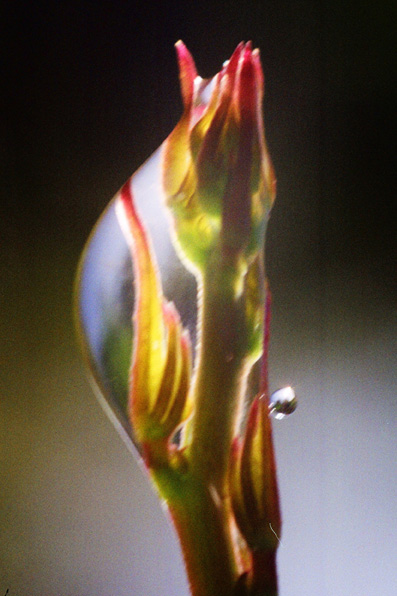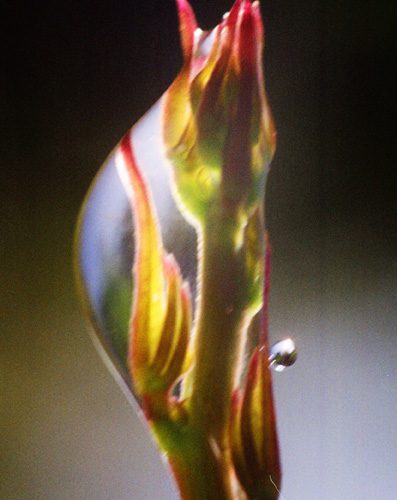
Pictures: Dalat is known as ‘the city of love in Southern Highlands’ for more banal reasons. Here, in a dewdrop, and on the next four pages is how MPK sees the love, especially in loving insects and pine trees that release ‘blood’, ‘tears’ or ‘gems’.
Photos: Nguyen Van Phuoc (MPK)
Vietnam Heritage, February 2011 — When I asked why he chose to live a poor life to follow a long career like his, Nguyen Van Phuoc answered: ‘I can clearly see that nature protects us. However, we keep destroying it non-stop. Seeing that hurts me a lot. So I capture beautiful moments of nature for people to open their eyes to see how beautiful it is. I believe that, seeing the honest, pure and dreamy beauty of nature can stop people from destroying it.’
After taking a sip of water, as if to calm his emotion down, he continued: ‘The most recent pain to me was when I saw people killing pine trees in a sophisticated way by whittling the cover of their bodies. After a while, they will be withered and die. And when they die, there will be reasons for people to build projects. Because they know that if a project or a house is being planned for a bald hill, public opinion won’t be as noisy as when they cut down pine trees for their project.’
Interrupting him, I asked: ‘So you took photos of dying pine trees to make an accusation about the act of destroying the environment?’ ‘No. It was the pine trees who accused humans. Before they died, their wounds bled streams of resin. Those are their streams of hatred blood. Sometimes I think those resin streams are the pines’ tears for people’s casualness and cruelty. Sometimes those resin drops suddenly become shiny gems to me. So I’ve decided to express these three views for people to think about.’
Before a planned exhibition on pine exudates at T?t, Phuoc said, ‘If I can’t find an exhibition hall, I will choose a hill to display this photo series.’
He also said there was a time he put a lot of effort into taking pictures of polluted, stinking puddles.
‘So it means that you want to use “photo language” to describe human’s cruelty to nature?’ I asked. ‘No. Actually, I prefer using a photo language that is full of love, brightness, nature, peace and romance to convert humans rather than using cold photo language to accuse them. That is why about 90 per cent of my photos have gentle, innocent, simple and romantic themes. For instance, I’ve captured a collection of insect-making-love photos.’
He then gave me those photos. I was stunned in looking at them: photos of two butterflies sticking themselves together, two dragonflies curving their tails to knit them up and grasshoppers lying on each other.
‘While I was taking pictures of these insects, I could feel that they were very honest, their loves had no languages or styles. Making love was their inspiration. I wished I could become an insect to understand them.’
Phuoc was born in Dalat in 1958. He is the youngest child of a family where no one else is an artist. As a child, he was interested in discovering the universe and also loved music. However, he was heavily influenced by the American lifestyle popular in many urban areas of southern Vietnam at the time and often left home to wander when he was still in elementary school. ‘Fifteen years old, seeing people killed by war (the American war), my soul was filled with loneliness, so I left home for bar girls and drugs to cheer myself up.’
When the American war ended, in 1975, Phuoc was old enough to work but was unemployed. He dealt drugs to make a living. Eventually, he spent two years in prison. When he was released, he ran around Dalat’s warehouses and terminals, working as a porter. That job did not earn him enough money, so in 1982 he started working as a photographer, strolling around tourists and entertainment. The passion for photography got into him gradually. ‘Because of this passion, not until I was 51 did I get married,’ he said.
Phuoc doesn’t know how to use any means of personal transport. Every day, from 5 a.m., Phuoc starts his ‘hunt’ by putting on his old backpack and carrying his old camera, of which all the setting numbers have gone, and leaves his house without any destination in mind.
People in Dalat usually see Phuoc in different postures: crawling and rolling, lying on his back or one of his sides, climbing on trees or even standing alone on a mountainside to point his camera anywhere: to the sky, to plants, to rock caves or dirt caves or stinking puddles.
At about 7 a.m., Phuoc usually has coffee at Tung café, which has been there for 60 years. Then, at 8.30 a.m., he begins his hunt until the evening, when he comes home, to his room, which is only ten square metres, in Thu Khoa Huan Street, Ward 1, Dalat. The room is a mess with books and photos, records and old cameras.
‘On nights when Dalat has special things like lightning on the sky or strongly bright moon, or moon skidding with clouds, I bring my camera out to take photos,’ Phuoc said.
Sometimes, he puts his backpack on and travels the forest for as long as a month to take photos.
His passion for photography is so great that it makes people call him ‘Phuoc Khung’. People in Dalat, from officials to xe ôm (motorbike taxis) and farmers, all know him. He uses the initials ‘MPK’ for his works – M for his Christian name, Michel, P for Phuoc and K for his nickname, Khung. He even admitted that he was khung (which means crazy).
Not liking to be with people, he only wants to be friends with nature. ‘Nature just gives without asking anything in return,’ he said. Taking photos of nature in silence and the tranquillity of the forest, or more violent scenes like lightning flashes, whirlwinds and storms, is his favourite. I questioned: ‘How can you take photographs of invisible things like the wind?’ He said: ‘Waving bamboo, shaking pine trees and blown flowers. That is how I capture the wind.’
In gaining more experience in taking beautiful photos, MPK is a patient man. ‘It took me a year to learn how to capture a flash of lightning. If I want to take photos of insects, I have to study their habits of how they depend on weather. If it is a bee, after every rain, it becomes so addicted to sucking nectar that even if I put my camera very close to it, it won’t fly away. Then I can take photos as much as I want. When it’s sunny, bees and butterflies rarely alight in the same place.’
The most special photo was the one that contained his ambition of capturing the whole universe in a dewdrop. For the first time, I’ve seen a bright red flower reflected in a drop of dew. It was like the flower was being burnt inside the dewdrop. ‘To have this photo,’ MPK said, ‘I had to lie down on the side of a hill, press my camera nearly against the dewdrop and many times, hold my breath and use an entire roll of film. And to capture a dewdrop, I was soaking wet with dew.’
Not only saving beautiful moments, MPK has also kept the history of the city that is famous of having a lot of old, valuable buildings. He gave me photos he took 25 years ago and discontentedly said, ‘This old villa was destroyed. This perennial pine tree was cut down too.’
MPK is one of the photographers who have taken the most photos of Dalat. He is the first person from Dalat who has exhibited far and wide. He has had 20 photo exhibitions at big cities, including Hanoi and Saigon.n

,,
,,

